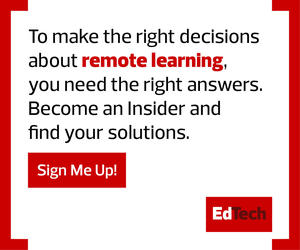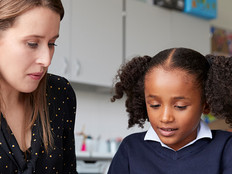What Is the Hybrid Learning Model and How Has it Evolved?
At its most basic, “hybrid learning uses online components for teaching and learning that replaces face-to-face classroom time,” says Verjeana McCotter-Jacobs, chief transformation officer for the National School Boards Association.
While initial hybrid learning approaches happened almost entirely at home — for both students and teachers — McCotter-Jacobs notes that in many cases, “teachers were in the classroom teaching both in-person and online as schools shifted from an all-remote approach to a combination of virtual and in-person classes.”
As a result, the hybrid model is now used to supplement multiple solutions for student success. In some schools, this means having students at home part time and in class part time; other districts have chosen to keep certain grade groups home full time and allow younger children to return in person.
How Does Hybrid Learning Differ from Blended Learning?
While the terms “hybrid learning” and “blended learning” are often used interchangeably, they’re not identical.
“It can be confusing, but when you think about blended learning, you’re not taking away from face time. Instead, it’s about providing online materials and tools that supplement learning rather than replacing the face-to-face experience,” says McCotter-Jacobs.
In practice, blended learning often takes the form of new initiatives such as project-based learning that add multimedia resources to common coursework and allow students to self-direct some of their learning to explore the holistic results of differing educational disciplines such as math, science or math and sciences.
Hybrid classes, meanwhile, take these online tools and provide them to students through remote learning portals and online learning management systems for use outside of the traditional school environment.
When it comes to hybrid learning vs. blended learning, here’s a good rule of thumb: If tools augment face-to-face frameworks, they’re blended learning models. If they facilitate the replacement of in-person instruction, they’re hybrid.
What Strategies Can Schools Use to Improve Hybrid Learning Models?
Recent research from the Economic Policy Institute suggests that online teaching and learning models can be effective “if students have consistent access to the Internet and computers and if teachers have received targeted training and supports for online instruction.”
McCotter-Jacobs echoes this sentiment, noting that “teachers in many cases are older and are not necessarily equipped for this technology.”
In fact, some of the biggest pain points that have emerged have less to do with the technology used to facilitate remote learning and hybrid learning itself and more to do with tech-challenged educators tasked with using that technology.
“The training and support they need is critical, and it’s not just for the software itself. How do they create lesson plans under this new model? How do they help students who are struggling? What happens when the software fails?” she says.
For McCotter-Jacobs, there’s one rule to follow when it comes to tapping the benefits of hybrid learning: Keep it simple. From streamlining the volume of applications and services students use to reducing the number of passwords and logins required to gain access, simplicity benefits students, teachers and parents alike.
DISCOVER: 5 tips for an effective hybrid instruction experience.
What Technologies Are Required for Effective Hybrid Learning Plans?
Hybrid classes are only effective when backed by the right technologies. For McCotter-Jacobs, this starts with Wi-Fi in school buildings, especially as some kids head back to the classroom part time.
She also notes, however, that in-school Wi-Fi isn’t enough to create effective hybrid learning plans because many families lack access to reliable broadband internet at home. “There’s a vast deficiency here,” says McCotter-Jacobs, “with at least 17 million students lacking access to high-speed internet.”
To address this issue, McCotter-Jacobs notes, some districts equipped school buses with Wi-Fi and then drove these buses into underserved neighborhoods. Still, she says, there is a need for broader support to address the digital divide in education. As a result, she says, the NSBA has called for an additional $12 billion from the federal government to help deal with the homework gap and help facilitate effective hybrid learning.
What Does the Next Iteration of Hybrid Learning Look Like?
For those under the assumption that hybrid learning is a temporary stopgap, McCotter-Jacobs cautions that “the new normal is not going away.”
As schools prepare for a potential return to the classroom in fall 2021, several elements of hybrid learning will remain. This could take the form of families opting for at-home learning out of an abundance of caution until vaccine rollouts reach a certain threshold or schools choosing a partially hybrid model to reduce classroom overcrowding and improve one-on-one interaction.
That’s why it’s important for educators to embrace the hybrid learning shift as a foundational change to be absorbed and implemented into the broader plan and vision for the future of education.
“There’s an opportunity here for schools to get creative and shift the way students learn and the way teachers provide guidance,” says McCotter-Jacobs.
While she notes that this approach isn’t without its challenges, given “the many intangibles that we can’t put our finger on and the need for the right combination of funds, training and creative minds,” McCotter-Jacobs believes that hybrid learning can have a positive impact if it’s at the forefront of educational change.
“This shift can help take kids to the next iteration of learning,” she says, “and it’s not sitting in a classroom.”
MORE ON EDTECH: Google for education offers an effective ecosystem for hybrid learning.










